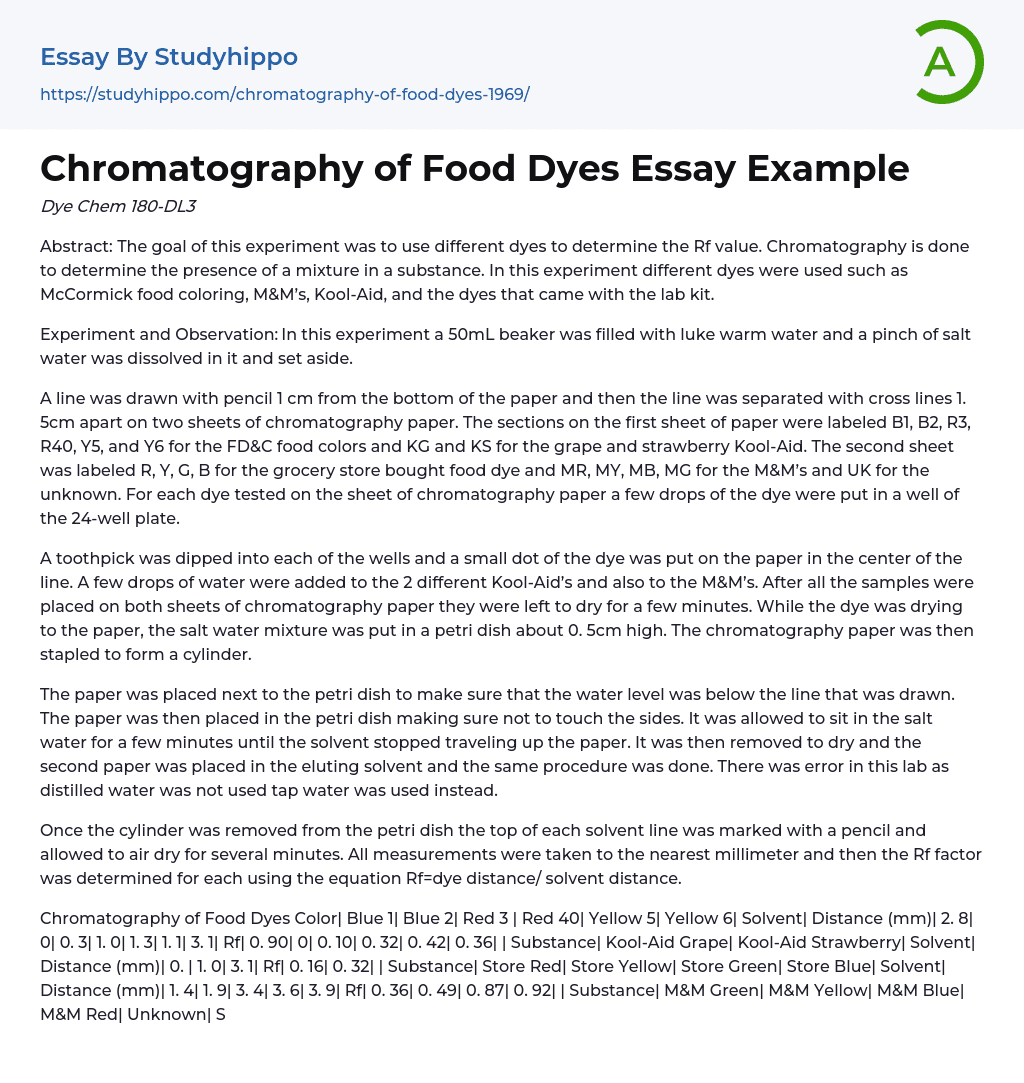Abstract
The goal of this experiment was to use different dyes to determine the Rf value. Chromatography is done to determine the presence of a mixture in a substance. In this experiment different dyes were used such as McCormick food coloring, M&M’s, Kool-Aid, and the dyes that came with the lab kit.
Experiment and Observation
In this experiment a 50mL beaker was filled with luke warm water and a pinch of salt water was dissolved in it and set aside.
A line was drawn with pencil 1 cm from the bottom of the paper and then the line was separated with cross lines 1. 5cm apart on two sheets of chromatography paper. The sections on the first sheet of paper were labeled B1, B2, R3, R40, Y5, a
...nd Y6 for the FD&C food colors and KG and KS for the grape and strawberry Kool-Aid. The second sheet was labeled R, Y, G, B for the grocery store bought food dye and MR, MY, MB, MG for the M&M’s and UK for the unknown. For each dye tested on the sheet of chromatography paper a few drops of the dye were put in a well of the 24-well plate.
A toothpick was dipped into each of the wells and a small dot of the dye was put on the paper in the center of the line. A few drops of water were added to the 2 different Kool-Aid’s and also to the M&M’s. After all the samples were placed on both sheets of chromatography paper they were left to dry for a few minutes. While the dye was drying to the paper, the salt water mixture was put in a petr
dish about 0. 5cm high. The chromatography paper was then stapled to form a cylinder.
The paper was placed next to the petri dish to make sure that the water level was below the line that was drawn. The paper was then placed in the petri dish making sure not to touch the sides. It was allowed to sit in the salt water for a few minutes until the solvent stopped traveling up the paper. It was then removed to dry and the second paper was placed in the eluting solvent and the same procedure was done. There was error in this lab as distilled water was not used tap water was used instead.
Once the cylinder was removed from the petri dish the top of each solvent line was marked with a pencil and allowed to air dry for several minutes. All measurements were taken to the nearest millimeter and then the Rf factor was determined for each using the equation Rf=dye distance/ solvent distance.
Questions
- A. Why can’t a pen be used to draw the baseline on the chromatography paper? A pen cannot be used because there is dye in the ink and will bleed into the dye samples being used.
- B.Why is it important to stop the chromatograph before the solvent reaches the top of the paper? If the solvent reached the top of the paper the correct measurement would not be calculated.
- C. Why is it important to keep the dye spots above the solvent level? It is important because if the solvent was above the dye spots a line would not be made and the dye would bleed to the sides and down
- Food Safety essays
- Food Security essays
- Beverages essays
- Cuisines essays
- Dairy essays
- Desserts essays
- Fast Food essays
- Bread essays
- Meal essays
- Meat essays
- Organic Food essays
- Rice essays
- Sugar essays
- Taste essays
- Beef essays
- Coconut essays
- Crowd essays
- Dinner essays
- Juice essays
- Sainsbury essays
- Cooking essays
- Ginger essays
- Oreo essays
- Drink essays
- Beer essays
- Wine essays
- Coffee essays
- Tea essays
- Cake essays
- Hamburger essays
- Ice Cream essays
- Burger essays
- Pizza essays
- Fruit essays
- Lemon essays
- Food Waste essays
- Favorite Food essays
- Alcoholic essays
- Soft Drinks essays
- Cookie essays
- Starch essays
- Yeast essays
- Cola essays
- Pizza Hut essays
- snack foods essays
- chips essays
- Biscuit essays
- Brewing essays
- Brewery essays
- Research Methods essays




